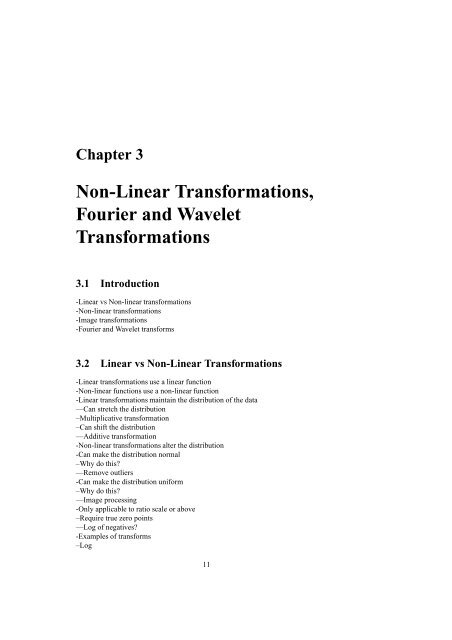Non-Linear Transformations, Fourier and Wavelet Transformations
Non-Linear Transformations, Fourier and Wavelet Transformations
Non-Linear Transformations, Fourier and Wavelet Transformations
You also want an ePaper? Increase the reach of your titles
YUMPU automatically turns print PDFs into web optimized ePapers that Google loves.
Chapter 3<br />
<strong>Non</strong>-<strong>Linear</strong> <strong>Transformations</strong>,<br />
<strong>Fourier</strong> <strong>and</strong> <strong>Wavelet</strong><br />
<strong>Transformations</strong><br />
3.1 Introduction<br />
-<strong>Linear</strong> vs <strong>Non</strong>-linear transformations<br />
-<strong>Non</strong>-linear transformations<br />
-Image transformations<br />
-<strong>Fourier</strong> <strong>and</strong> <strong>Wavelet</strong> transforms<br />
3.2 <strong>Linear</strong> vs <strong>Non</strong>-<strong>Linear</strong> <strong>Transformations</strong><br />
-<strong>Linear</strong> transformations use a linear function<br />
-<strong>Non</strong>-linear functions use a non-linear function<br />
-<strong>Linear</strong> transformations maintain the distribution of the data<br />
—Can stretch the distribution<br />
–Multiplicative transformation<br />
–Can shift the distribution<br />
—Additive transformation<br />
-<strong>Non</strong>-linear transformations alter the distribution<br />
-Can make the distribution normal<br />
–Why do this?<br />
—Remove outliers<br />
-Can make the distribution uniform<br />
–Why do this?<br />
—Image processing<br />
-Only applicable to ratio scale or above<br />
–Require true zero points<br />
—Log of negatives?<br />
-Examples of transforms<br />
–Log<br />
11
12 CHAPTER 3. NON-LINEAR TRANSFORMATIONS<br />
–Exponential<br />
—Inverse of log<br />
–Binomial<br />
–Tanh<br />
3.3 Image <strong>Transformations</strong><br />
-Many image processing transformations are non-linear<br />
–Why?<br />
-Examples<br />
–Convolution<br />
–Sobel filters<br />
–Median filters<br />
-Convolution<br />
–General technique<br />
–Uses a small matrix<br />
—Kernel<br />
–Kernel is slid over the image<br />
—Moves one pixel at a time<br />
–Values in the kernel are used to transform values in image<br />
–Basis of many image processing techniques<br />
-Sobel filter<br />
–Based on a convolution<br />
–Edge detector<br />
–Edges have high contrast<br />
–Measures the gradient between adjacent groups of pixels<br />
–Uses specific kernel values<br />
-Median filters<br />
–Family of filters<br />
–Noise reduction<br />
—Impulse noise<br />
–Examine groups of pixels<br />
–Remove spikes in intensity<br />
–Different methods used<br />
—Not all non-linear<br />
3.4 Signals <strong>and</strong> Waves<br />
3.4.1 Signals<br />
-What is a signal?<br />
-Change in a variable over time<br />
-Many things can be treated as signals<br />
–Sound<br />
–Light<br />
–Images<br />
–DNA
3.5. FOURIER TRANSFORMATIONS 13<br />
-Signal processing is an important field in computing<br />
3.4.2 Properties of Waves<br />
-Displacement in a medium<br />
-Waves are signals<br />
-Waves can interfere with one another<br />
–Constructive<br />
–Destructive<br />
–Beats<br />
-Complex waves can be created<br />
–Use a large (possibly infinite) number of component waves<br />
-Visualisation of waves<br />
–Time domain<br />
–Frequency domain<br />
-Time domain is traditional<br />
–Amplitude vs time<br />
-Frequency domain is more useful for analysis<br />
3.5 <strong>Fourier</strong> <strong>Transformations</strong><br />
-Convert a signal into the frequency domain<br />
-Separates signal in components<br />
-Useful for many things<br />
–Analysis of the signal<br />
–Noise suppression<br />
–Signal modeling<br />
—Speech recognition<br />
-Discrete <strong>Fourier</strong> Transforms<br />
–DFT<br />
-Used for discretised signals<br />
–Ergo, digital signals<br />
-Fast <strong>Fourier</strong> Transforms<br />
–FFT<br />
-Efficient implementation of the DFT<br />
–Does the same thing quicker<br />
3.6 <strong>Wavelet</strong> <strong>Transformations</strong><br />
-What is a wavelet?<br />
-Two main properties<br />
–Limited duration<br />
–Average value of zero<br />
-A wavelet fades in <strong>and</strong> fades out<br />
-<strong>Wavelet</strong> analysis breaks a signal into its component wavelets
14 CHAPTER 3. NON-LINEAR TRANSFORMATIONS<br />
-<strong>Wavelet</strong> coefficients can be recombined to form the original signal<br />
-<strong>Wavelet</strong>s have many applications<br />
–Noise filtering<br />
–Compression<br />
-<strong>Wavelet</strong>s are used when FFT don’t work<br />
3.7 Summary<br />
-<strong>Non</strong>-linear transforms alter the distribution of data<br />
-Often used to transform images<br />
-Many image transformations are based on convolution<br />
-<strong>Fourier</strong> <strong>and</strong> wavelet transforms are other non-linear transformations<br />
-<strong>Fourier</strong> transforms break signals into component sinusoids<br />
-Used in many signal processing applications<br />
-DFT applied to DSP<br />
-FFT is an implementation of DFT<br />
-<strong>Wavelet</strong> transforms break signal into component wavelets<br />
-Used in signal compression among others



